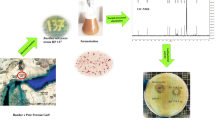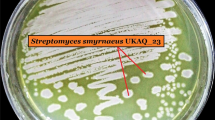Abstract
After separation of bacterial colonies on solid plates, purification, and screening through the agar cup-plate method, an antibiotic-resistant bacterial isolate was obtained, and named strain L20190601, the 16S rRNA gene sequence data of strain L20190601 to GenBank, NCBI have provided GenBank accession number MW931615. 16S rRNA gene sequencing revealed that this isolate was highly similar to a number of Streptomyces species. Among them, the homology with S. spectabilis was the highest, reaching 99.9, together with curved hyphal morphology and biochemical tests, allowed us to identify strain L20190601 as S. spectabilis. The red pigment produced by S. spectabilis strain L20190601 was structurally identified. An acid–base color reaction assay showed that when this pigment was dissolved in a solution at pH 3.0 and 9.0, the color of the solution was red and yellow, respectively. In addition, the analysis of absorption spectra revealed that at pH 8.0 and 3.0, the maximum absorption peaks were at 466 and 531 nm, respectively. These results are consistent with the spectral absorption characteristics of metacycloprodigiosin reported in the literature. Moreover, the retention time of purified pigments was identical to those of standard metacycloprodigiosin solutions. Mass spectrometry analysis revealed that the molecular weight of the red compound was 392.2 [M + H]+. Finally, metacycloprodigiosin was found to be effective against eight clinically common pathogens: Staphylococcus aureus, Bacillus subtilis, Escherichia coli, Streptococcus pyogenes, Pseudomonas aeruginosa, Bacillus typhi, Candida albicans, and Trichophyton rubrum. In summary, metacycloprodigiosin exhibited strong antibacterial activity and a broad antibacterial spectrum, and thus is a promising compound for the development of a new type of antibacterial drug.




Similar content being viewed by others
References
Berdy J (2005) Bioactive microbial metabolites. J Antibiot (Tokyo) 58:1–26
Baltz RH (2017) Molecular beacons to identify gifted microbes for genome mining. J Antibiot (Tokyo) 70:639–646
Baltz RH (2017) Gifted microbes for genome mining and natural product discovery. J Ind Microbiol Biotechnol 44:573–588
Baltz RH (2019) Natural product drug discovery in the genomic era: realities, conjectures, misconceptions, and opportunities. J Ind Microbiol Biotechnol 46:281–299
Yin M, Jiang M, Ren Z, Dong Y, Lu T (2017) The complete genome sequence of Streptomyces autolyticus CGMCC 0516, the producer of geldanamycin, autolytimycin, reblastatin and elaiophylin. J Biotechnol 252:27–31
Sinha A, Phillips-Salemka S, Niraula TA, Short KA, Niraula NP (2019) The complete genomic sequence of Streptomyces spectabilis NRRL-2792 and identification of secondary metabolite biosynthetic gene clusters. J Ind Microbiol Biotechnol 46:1217–1223
Zuo L, Jiang B, Jiang Z, Zhao W, Li S, Liu H, Hong B, Yu L, Zuo L, Wu L (2016) Hangtaimycin, a peptide secondary metabolite discovered from Streptomyces spectabilis CPCC 200148 by chemical screening. J Antibiot (Tokyo) 69:835–838
Chater KF (2016) Recent advances in understanding Streptomyces. 5:2795
Gomez-Escribano JP, Castro JF, Razmilic V, Chandra G, Andrews B, Asenjo JA, Bibb MJ (2015) The Streptomyces leeuwenhoekii genome: de novo sequencing and assembly in single contigs of the chromosome, circular plasmid pSLE1 and linear plasmid pSLE2. BMC Genomics 16:485
Isaka M, Jaturapat A, Kramyu J, Tanticharoen M, Thebtaranonth Y (2002) Potent in vitro antimalarial activity of metacycloprodigiosin isolated from Streptomyces spectabilis BCC 4785. Antimicrob Agents Chemother 46:1112–1113
Genes C, Baquero E, Echeverri F, Maya JD, Triana O (2011) Mitochondrial dysfunction in Trypanosoma cruzi: the role of Serratia marcescens prodigiosin in the alternative treatment of Chagas disease. Parasit Vectors 4:66
Gulani C, Bhattacharya S, Das A (2012) Assessment of process parameters influencing the enhanced production of prodigiosin from Serratia marcescens and evaluation of its antimicrobial, antioxidant and dyeing potentials. Malays J Microbiol 8:116–122
Wang Z, Li B, Zhou L, Yu S, Su Z, Song J, Sun Q, Sha O, Wang X, Jiang W et al (2016) Prodigiosin inhibits Wnt/beta-catenin signaling and exerts anticancer activity in breast cancer cells. Proc Natl Acad Sci U S A 113:13150–13155
Tsuji RF, Yamamoto M, Nakamura A, Kataoka T, Magae J, Nagai K, Yamasaki M (1990) Selective immunosuppression of prodigiosin 25-C and FK506 in the murine immune system. J Antibiot (Tokyo) 43:1293–1301
Han SB, Park SH, Jeon YJ, Kim YK, Kim HM, Yang KH (2001) Prodigiosin blocks T cell activation by inhibiting interleukin-2Ralpha expression and delays progression of autoimmune diabetes and collagen-induced arthritis. J Pharmacol Exp Ther 299:415–425
Namazkar S (2013) Spray-dried Prodigiosin from Serratia Marcescens as A colorant. Biosci Biotech Res Asia 10:69–76
Ryazantseva I, Andreyeva I (2014) Application of prodigiosin as a colorant for polyolefines. Adv Biol Chem 04:20–25
Wasserman HH, Rodgers GC, Keith DD (1969) Metacycloprodigiosin, a tripyrrole pigment from Streptomyces longisporus ruber. J Am Chem Soc 91:1263–1264
Liu R, Cui CB, Duan L, Gu QQ, Zhu WM (2005) Potent in vitro anticancer activity of metacycloprodigiosin and undecylprodigiosin from a sponge-derived actinomycete Saccharopolyspora sp. nov. Arch Pharm Res 28:1341–1344
Magae J, Miller MW, Nagai K, Shearer GM (1996) Effect of metacycloprodigiosin, an inhibitor of killer T cells on murine skin and heart transplants. J Antibiot (Tokyo) 49:86–90
Rai NP, Narayanaswamy VK, Govender T, Manuprasad BK, Shashikanth S, Arunachalam PN (2010) Design, synthesis, characterization, and antibacterial activity of {5-chloro-2-[(3-substitutedphenyl-1,2,4-oxadiazol-5-yl)-methoxy]-phenyl}-(phenyl) -methanones. Eur J Med Chem 45:2677–2682
Arganaraz-Martinez E, Babot JD, Apella MC, Perez Chaia A (2013) Physiological and functional characteristics of Propionibacterium strains of the poultry microbiota and relevance for the development of probiotic products. Anaerobe 23:27–37
Patel JB (2014) Performance standards for antimicrobial susceptibility testing : twenty-fourth informational supplement: CLSI.
Wasserman HH, Keith DD, Nadelson J (1969) The synthesis of metacycloprodigiosin. J Am Chem Soc 91:1264–1265
Wasserman HH, Keith DD, Rodgers GC (1976) The structure of metacycloprodigiosin. Tetrahedron 32:1855–1861
Acknowledgements
This research was supported by the Natural Science Foundation of Guangxi Natural Science Foundation (Grant Number, 2018GXNSFBA294004), the Natural Science Foundation of Hubei Province (Grant Number, 2020CFB206), the Hubei Provincial Department of Education (Grant Number, Q20202805), the Guangxi Autonomous Region University Student Innovation and Entrepreneurship Project (Grant Numbers 202010605054 and 202010605068), and the Doctoral Foundation of HuBei University of Science & Technology Science (Grant Number BK202028).
Author information
Authors and Affiliations
Corresponding author
Ethics declarations
Conflict of interest
The authors declare that there are no conflicts of interest regarding the publication of this article.
Additional information
Publisher's Note
Springer Nature remains neutral with regard to jurisdictional claims in published maps and institutional affiliations.
Supplementary Information
Below is the link to the electronic supplementary material.
Rights and permissions
About this article
Cite this article
Meng-xi, L.I., Hui-bin, H., Jie-yun, L. et al. Antibacterial Performance of a Streptomyces spectabilis Strain Producing Metacycloprodigiosin. Curr Microbiol 78, 2569–2576 (2021). https://doi.org/10.1007/s00284-021-02513-w
Received:
Accepted:
Published:
Issue Date:
DOI: https://doi.org/10.1007/s00284-021-02513-w




